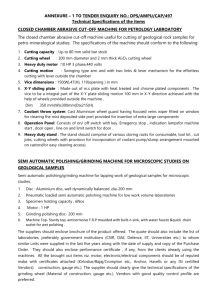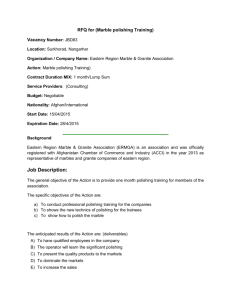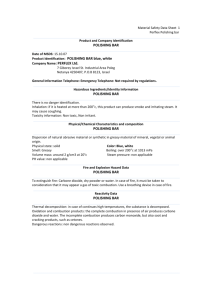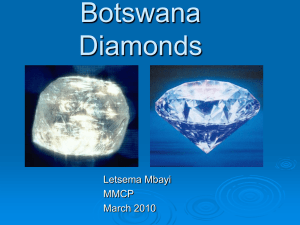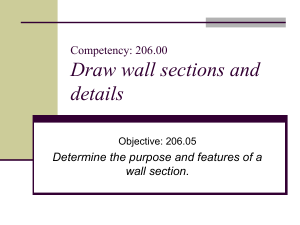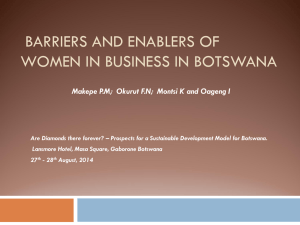Technological Innovation and Export Diversification - FES
advertisement
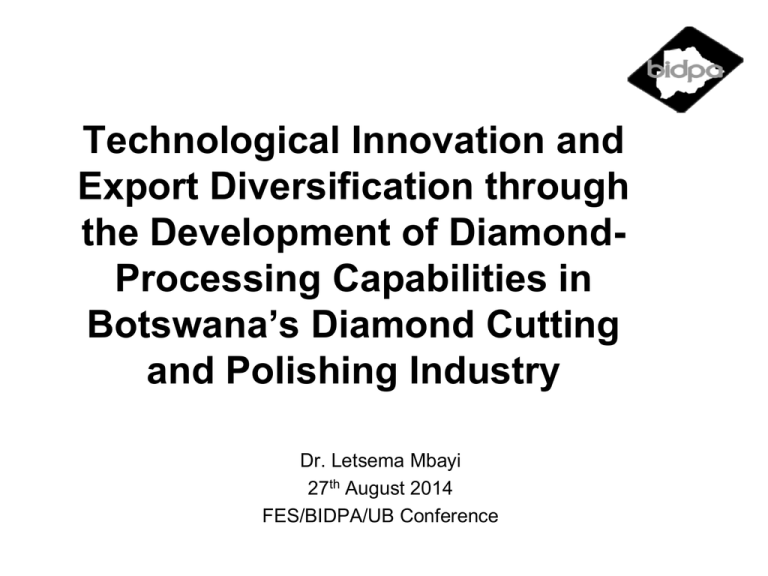
Technological Innovation and Export Diversification through the Development of DiamondProcessing Capabilities in Botswana’s Diamond Cutting and Polishing Industry Dr. Letsema Mbayi 27th August 2014 FES/BIDPA/UB Conference The Government’s Ambitious Plan • Transform the country into a Diamond Centre by developing downstream capabilities in: • Cutting and Polishing • Trading • Jewellery Manufacturing • Ancillary services • To achieve this the government signed ground breaking agreements with DeBeers in 2005 and 2012 to help establish a downstream industry • Local rough diamond sales • Independent sales window • 20 cutting and polishing companies have been licensed in Botswana • Receive rough diamond allocations on a number of conditions, including that they train locals with cutting and polishing skills The Cutting and Polishing Skills • Diamonds are cut and polishing using a series of steps, • maximum light reflection and refraction, giving polished diamonds their sparkle • Traditionally the skills are craft skills • Learnt over long apprentices • Tacit knowledge was crucial in the craft • Technological revolution that started industry in the 1980s • has changed the nature and mix of skills used in cutting and polishing process. • From tacit to codified knowledge • Technologies like laser, computer numerically controlled (CNC) machines and computer-aided design (CAD) have • increased accuracy and improved the quality of the polished diamonds • Knowledge codification has simplified the skills needed by production workers and simultaneously enhanced the skills required in machine maintenance. The Current Development of Diamond-Processing Capabilities in Botswana • All cutting centres built capabilities by transferring skills from expatriates to locals • Government provides general skills (basic education) • Firms are providing industry and firm-specific skills mainly through on-the-job training • There are plans for the provision institutional training – To reduce the firms’ costs of training – Create more local knowledge on the downstream industry (regulators, service providers) – But the current level of institutional training is still very low Botswana’s Opportunity • Since Botswana is a latecomer to the industry, • provided the scope for it to leapfrog to the most efficient technologies • aiding the country’s ability to build diamond-processing capabilities • State-of-the-art factories using the latest technologies in the industry • These technologies are making firm training for production jobs more efficient since less tacit knowledge needs to be transferred to workers during training • Generally the firms were impressed with how quickly training was taking place amongst locals for production jobs but the development of maintenance skills was less satisfactory • Weakness in institutional training is affecting the country absorptive capacity for the new technologies • Maintenance skills • Related technical skills The Changing Composition of Diamond Exports 6000 US($) Millions 5000 4000 3000 2000 1000 0 2003 2004 2005 2006 2007 2008 Rough Polished 2009 2010 2011 2012 2013 Policy Implications • • • • Yes technology does mean that potentially less jobs are created But you build more competitive industries faster Competitiveness is crucial for a latercomer to any industry Technology needs to be seen as a good thing and not just a threat to job creation • Leapfrogging • Policies needs to support technological absorptive capacity in new industries • Training • Technological acquisition • Policies also need to encourage global firms to play an active role locally in technological development • Through the innovation hub – policy coherence • Innovate technologies that are more relevant to the local conditions • BUT issues of productivity need to be addressed with separate policies • e.g. Benchmarking Thank you

